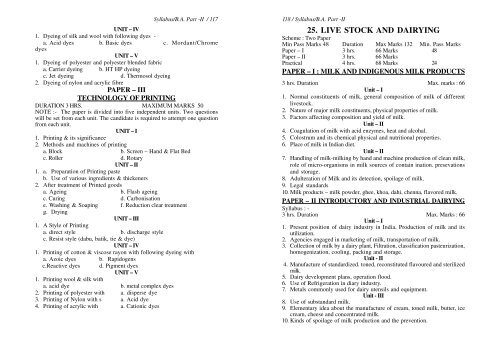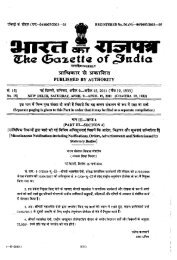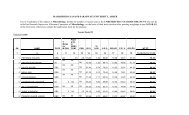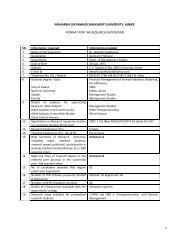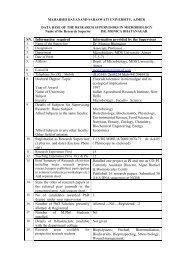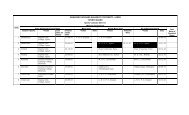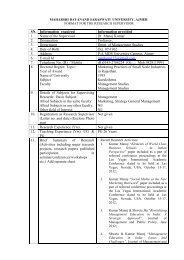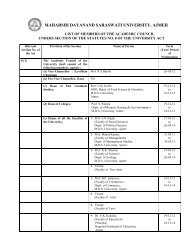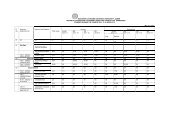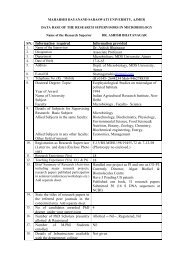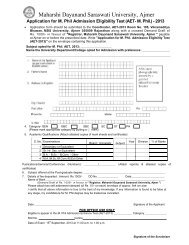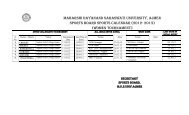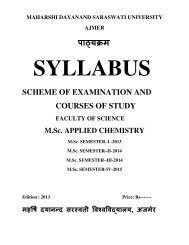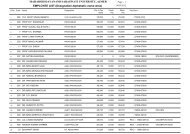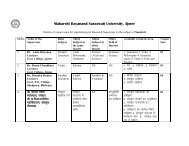ba pt II - Maharshi Dayanand Saraswati University, Ajmer, Rajasthan
ba pt II - Maharshi Dayanand Saraswati University, Ajmer, Rajasthan
ba pt II - Maharshi Dayanand Saraswati University, Ajmer, Rajasthan
You also want an ePaper? Increase the reach of your titles
YUMPU automatically turns print PDFs into web optimized ePapers that Google loves.
UNIT – IV<br />
1. Dyeing of silk and wool with following dyes -<br />
a. Acid dyes b. Basic dyes c. Mordant/Chrome<br />
dyes<br />
UNIT – V<br />
1. Dyeing of polyester and polyester blended fabric<br />
a. Carrier dyeing b. HT HP dyeing<br />
c. Jet dyeing d. Thermosol dyeing<br />
2. Dyeing of nylon and acrylic fibre<br />
PAPER – <strong>II</strong>I<br />
TECHNOLOGY OF PRINTING<br />
DURATION 3 HRS. MAXIMUM MARKS 50<br />
NOTE :- The paper is divided into five independent units. Two questions<br />
will be set from each unit. The candidate is required to attem<strong>pt</strong> one question<br />
from each unit.<br />
UNIT – I<br />
1. Printing & its significance<br />
2. Methods and machines of printing<br />
a. Block b. Screen – Hand & Flat Bed<br />
c. Roller d. Rotary<br />
UNIT – <strong>II</strong><br />
1. a. Preparation of Printing paste<br />
b. Use of various ingredients & thickeners<br />
2. After treatment of Printed goods<br />
a. Ageing b. Flash ageing<br />
c. Curing d. Carbonisation<br />
e. Washing & Soaping f. Reduction clear treatment<br />
g. Drying<br />
UNIT – <strong>II</strong>I<br />
1. A Style of Printing<br />
a. direct style b. discharge style<br />
c. Resist style (dabu, <strong>ba</strong>tik, tie & dye)<br />
UNIT – IV<br />
1. Printing of cotton & viscose rayon with following dyeing with<br />
a. Azoic dyes b. Rapidogens<br />
c.Reactive dyes d. Pigment dyes<br />
UNIT – V<br />
1. Printing wool & silk with<br />
a. acid dye b. metal complex dyes<br />
2. Printing of polyester with a. disperse dye<br />
3. Printing of Nylon with s a. Acid dye<br />
4. Printing of acrylic with a. Cationic dyes<br />
Syllabus/B.A. Part -<strong>II</strong> / 117 118 / Syllabus/B.A. Part -<strong>II</strong><br />
25. LIVE STOCK AND DAIRYING<br />
Scheme : Two Paper<br />
Min Pass Marks 48 Duration Max Marks 132 Min. Pass Marks<br />
Paper – I 3 hrs. 66 Marks 48<br />
Paper – <strong>II</strong> 3 hrs. 66 Marks<br />
Practical 4 hrs. 68 Marks 24<br />
PAPER – I : MILK AND INDIGENOUS MILK PRODUCTS<br />
3 hrs. Duration Max. marks : 66<br />
Unit – I<br />
1. Normal constituents of milk, general composition of milk of different<br />
livestock.<br />
2. Nature of major milk constituents, physical properties of milk.<br />
3. Factors affecting composition and yield of milk.<br />
Unit – <strong>II</strong><br />
4. Coagulation of milk with acid enzymes, heat and alcohal.<br />
5. Colostrum and its chemical physical and nutritional properties.<br />
6. Place of milk in Indian diet.<br />
Unit – <strong>II</strong><br />
7. Handling of milk-milking by hand and machine production of clean milk,<br />
role of micro-organisms in milk sources of contain ination. presevations<br />
and storage.<br />
8. Adulteration of Milk and its detection, spoilage of milk.<br />
9. Legal standards<br />
10. Milk products – milk powder, ghee, khoa, dahi, chenna, flavored milk.<br />
PAPER – <strong>II</strong> INTRODUCTORY AND INDUSTRIAL DAIRYING<br />
Syllabus : -<br />
3 hrs. Duration Max. Marks : 66<br />
Unit – I<br />
1. Present position of dairy industry in India, Production of milk and its<br />
utilization.<br />
2. Agencies engaged in marketing of milk, transportation of milk.<br />
3. Collection of milk by a dairy plant, Filtration, classification pasteurization,<br />
homogenization, cooling, packing and storage.<br />
Unit - <strong>II</strong><br />
4. Manufacture of standardized. toned, reconstituted flavoured and sterilized<br />
milk.<br />
5. Dairy development plans, operation flood.<br />
6. Use of Refrigeration in diary industry.<br />
7. Metals commonly used for dairy utensils and equipment.<br />
Unit - <strong>II</strong>I<br />
8. Use of substandard milk.<br />
9. Elementary idea about the manufacture of cream, toned milk, butter, ice<br />
cream, cheese and concentrated milk.<br />
10. Kinds of spoilage of milk production and the prevention.


